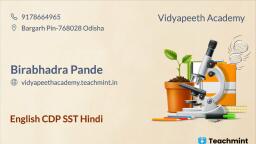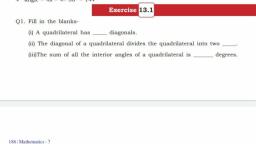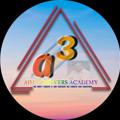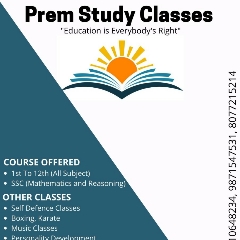Question 1 :
M is the midpoint of $\displaystyle\overline{AB}$. The coordinates of A are $(-2,3)$ and the coordinates of M are $(1,0)$. Find the coordinates of B.
Question 2 :
State true or false:In quadrilateral ABCD, the diagonals AC and BD intersect each at point O. If $AO=2CO$ and $BO=2DO$; Then, $\displaystyle OA \times OD=OB\times OC$.<br/>
Question 3 :
If the vertices of a quadrilateral be $A = 1 + 2i, B = -3 + i, c = -2 - 3i $ and $D = 2 - 2i$, then the quadrilateral is a:
Question 4 :
A triangle ABC in which AB=AC, M is a point on AB and N is a point on AC such that if BM=CN then AM=AN
Question 5 :
The quadrilateral whose vertices are $A \, (-2 , 5), \, B \, (4, -1)\,, C \, (9,1) \,, D \, (3, 7)$ is a parallelogram 
Question 6 :
One side of a parallelogram has length $3$ and another side has length $4$. Let $a$ and $b$ denote the lengths of the diagonals of the parallelogram. Which of the following quantities can be determined from the given information ?<br/>(l) a$  +  b$      (II)$\  a^{2}+b^{2}$      (III)$\  a^{3}+b^{3}$<br/>
Question 7 :
Two adjacent angles of a parallelogram are $2x+ 30$ and $5x + 30$. Then the value of $x$ is ___ .<br/>
Question 8 :
The diagnols of a parallelogram $PQRS$ are along the line $x+3y=4$ and $6x-2y=7$ then $PQRS$ must be a
Question 9 :
If A $(1, 0)$, B$ ( 5, 3)$, C $(2,7)$ and D $( x, y$) are vertices of a parallelogram ABCD, the co-ordinates of D are  
Question 10 :
The consecutive angles of a trapezium form an arithmetic sequence. If the smallest angle is $\displaystyle 75^{\circ}$, then the largest angle is
Question 11 :
State true or false:<br/>In triangle  $ ABC  $,  $ P  $ is the mid-point of side  $ BC  $. A line through $ P  $ and Parallel to  $ CA  $ meets  $ AB  $ at point  $ Q  $; and a line through  $ Q  $ and parallel to  $ BC $ meets median  $ AP  $ at point  $ R  $. Can it be concluded that,$ AP= 2AR $ ?<br/><br/>
Question 12 :
Opposite angles of a quadrilateral $ABCD$ are equal. If $AB = 4$ cm, determine $CD$.<br/>
Question 13 :
In a $\triangle DEF$; $A,B$ and $C$ are the mid-points of $EF,FD$ and $DE$ respectively. If the area of $\triangle DEF$ is $14.4{ cm }^{ 2 }$, then find the area of $\triangle {ABC}$.
Question 14 :
Tangents <i>PA</i> and <i>PB</i> drawn to $ x^2+y^2=9 $ from any arbitrary point <i>'P</i>' on the line $ x+y=25 $. Locus of midpoint of chord <i>AB</i> is
Question 15 :
$ABCD$ is a square with centre $O$. If $X$ is on the side $CD$ such that $DX=DO$, find the ratio $\angle DOX:\angle XOC$
Question 16 :
If the points A$ (a, -10)$, B $(6, b)$, C $(3, 16)$, D $(2, -1)$ are the vertices of a parallelogram ABCD, find the values of $a$ and $b$
Question 17 :
If $ABCD$ is a parallelogram with diagonals intersecting at $O$, then the number of distinct pairs of congruent triangles formed is:
Question 18 :
To construct a parallelogram, the minimum number of measurements required is
Question 19 :
The angles of a quadrilateral are in the ratio 3 : 2 : 4 : 1. Find the angles. Assign a special name to the quadrilateral.
Question 20 :
The ends of a diagonal of a parallelogram are $(3, -4)$and $(-6, 5)$, If the third vertex is $(-2, 1)$, then the fourth is-<br/>
Question 21 :
The area of the parallelogram with vertices $(0,0), (7,2),(5,9)$ and $(12,11)$ is
Question 22 :
If $D, E, F$ are respectively the midpoints of the sides $AB, BC, CA$ of $\Delta ABC$ and the area of $\Delta ABC$ is $24\ sq.\ cm$, then the area of $\Delta DEF$ is:
Question 23 :
If there consecutive vertices of a parallelogram are $(1, -2)$, $(3, 6)$ and $( 5, 10)$, then its fourth vertex is
Question 24 :
L and M are the mid-points of sides AB and DC respectively of parallelogram ABCD. Prove that segments DL and BM trisect diagonal AC. StateTrue or False.
Question 25 :
ABCD is a rhombus in which the altitude from D to side AB bisects AB. Then $\angle$A and $\angle$B respectively, are __________.
Question 26 :
State true or false:<br/>In triangle $ ABC $, angle $ B $ is obtuse. $ D $ and $ E $ are mid-points of sides $ AB $ and $ BC $ respectively and $ F $ is a point in side $ AC $ such that $ EF $ is parallel to $ AB $. Then, $ BEFD $ is a parallelogram. 
Question 27 :
In a triangle $\triangle ABC$, points <i>P</i>, <i>Q</i> and <i>R</i> are the mid-points of the sides <i>AB</i>, <i>BC</i> and <i>CA</i> respectively. If the area of the triangle<i> ABC </i>is 20 sq.units, then area of the<i> </i>triangle<i> PQR</i> equal to:<br/>
Question 28 :
P is a point on side BC of a parallelogram ABCD. If DP produced meet AB produced at point L, then<br/>$DP:PL=DC: BL$<br/>
Question 30 :
In a quadrilateral $ABCD$ <br> $AB\, +\, BC\, +\, CD\, +\, DA> 2AC$<br/><b>Say true or false.</b><br/>
Question 31 :
Diagonals AC and BD of a parallelogram ABCD intersect each other at O.If OA = 3 cm and OD = 2 cm, determine the length of AC.<br/><br/>
Question 32 :
In triangle ABC, D and E are mid-points of sides AB and BC respectively. Also, F is a point in side AC so that DF is parallel to BC.Find the perimeter of parallelogram DBEF, if AB = 10 cm, BE = 8.4 cm and AC = 12 cm.
Question 33 :
The area of rectangle ABCD with vertices A (0,0), B (5,0), C (5, 6) and D (0,6) is 
Question 34 :
The perimeter of a parallelogram ABCD = 40 cm, AB = 3x cm, BC = 2x cm and CD = 2(y +1) cm. Find the values of x and y.
Question 35 :
In parallelogram ABCD, $\angle A  = 3 \angle B$. In the same parallelogram, if AB $= 5x-7$ and $CD = 3x + 1$; find the length of CD.
Question 36 :
If in quadrilateral $ABCD$, $AB \parallel CD$, then $ABCD$ is necessarily a
Question 37 :
Find the angles of a parallelogram if one angle is three times another.
Question 38 :
If the bisectors of the angles $A$ and $B$ of a quadrilateral $ABCD$ meet at $O$, then $\angle AOB$ is equal to:
Question 39 :
Diagonals AC and BD of a parallelogram ABCD intersect each other at O.If OA = 3 cm and OD = 2 cm, determine the length of AC.<br/><br/>
Question 40 :
In triangle$ABC$,$M$is mid-point of$AB$and a straight line through$M$andparallel to$BC$cuts$AC$in$N$. Find the lenghts of$AN$and$MN$if $ BC= 7$ cm and $ AC= 5 $ cm.
Question 41 :
The quadrilateral formed by joining the mid-points of the sides of a quadrilateral PQRS, taken in order, is a rectangle, if <br/>
Question 42 :
If A $(-2, -1)$, B$ (a , 0)$, C$ ( 4, b)$ and D $(1, 1 )$ are the vertices of a parallelogram, then the values of $a$ and $b$ respectively are 
Question 43 :
If the lengths of the medians $AD, BE$ and $CF$ of the triangle $ABC$, are $6,8,10$ respectively, then<br>
Question 44 :
In a quadrilateral $ABCD,$ the point $P$ divides $DC$ in the ratio $1:2$ and $Q$ is the mid point of $AC$. If $AB + 2AD + BC - 2DC = k PQ,$ then $k$ is equal to:
Question 45 :
The area of the parallelogram with vertices $(0,0), (7,2),(5,9)$ and $(12,11)$ is
Question 46 :
$ P,Q, R $ and $ S $ are the mid-points of sides $ AB, BC, CD $ and $ DA $ respectively of rhombus $ ABCD $. Quadrilateral $ PQRS $ is a rectangle. Under what condition will $ PQRS $ be a square ?
Question 47 :
State true or false:For the case of a parallelogram the bisectors of opposite angles are not parallel to each other.<br/>
Question 48 :
If ABCD is a quadrilateral then $\tan { \left( \dfrac { A+B }{ 4 } \right) } =$
Question 49 :
In parallelogram ABCD, $\angle A  = 3 \angle B$. In the same parallelogram, if AB $= 5x-7$ and $CD = 3x + 1$; find the length of CD.
Question 50 :
State true or false:For the case of a parallelogram the bisectors of any two adjacent angles intersect at $90^{0}$.<br/>

































